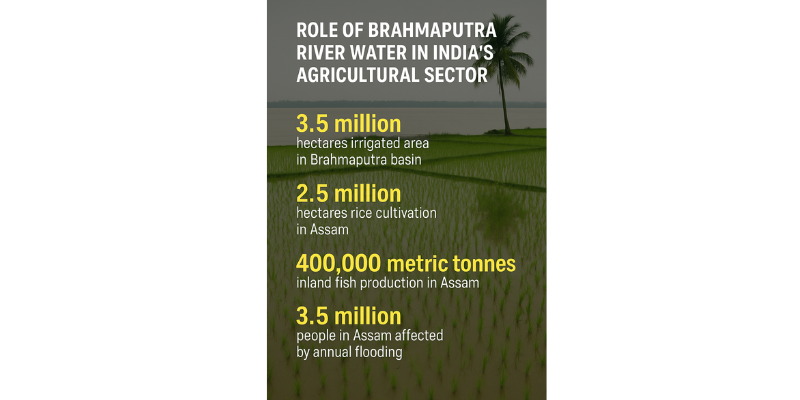Title: The Role Played by Brahmaputra River Water in Indian Agriculture
Prepared by:
Dr. P. Praveen
Associate Professor
Department of CSE, SR University
Warangal, Telangana – 506371
Abstract
The Brahmaputra River, one of the most powerful rivers in the world, plays a vital role in sustaining India’s agricultural economy, particularly in the northeastern region. This paper explores the multifaceted contributions of the Brahmaputra River to agriculture—ranging from irrigation and soil fertility to fisheries and climate regulation—while also addressing the challenges posed by seasonal flooding and climate change.
1. Introduction
The Brahmaputra River, originating in Tibet as the Yarlung Tsangpo, traverses Arunachal Pradesh and Assam before entering Bangladesh. It serves not just as a physical geographic feature but also as an economic lifeline for millions who depend on its waters for agriculture. The Indian stretch of the Brahmaputra basin covers approximately 194,413 square kilometers, where agriculture depends heavily on the river’s water availability, distribution, and utilization.
2. Agriculture and India’s Economy
Agriculture remains central to India’s economy, contributing 16–17% to the GDP and employing nearly 42% of the workforce (as of 2023). River basins such as the Brahmaputra are critical for irrigation, enhancing soil quality, supporting fisheries, and moderating climate-related variables that influence crop production.
3. Irrigation Potential of the Brahmaputra River
The Brahmaputra and its tributaries—such as the Subansiri, Manas, and Dhansiri—offer a perennial water supply, enabling year-round cultivation across most of Assam. Approximately 3.5 million hectares in the Brahmaputra basin are irrigated, primarily for rice cultivation. Of this, Assam alone cultivates over 2.5 million hectares of paddy fields, primarily through river-fed irrigation systems. The availability of water also allows for multiple cropping seasons, boosting overall agricultural productivity.
4. Soil Fertility and Alluvial Deposits
Seasonal flooding of the Brahmaputra deposits nutrient-rich alluvium on its floodplains, greatly enhancing soil fertility and reducing the need for chemical fertilizers. The Brahmaputra valley possesses some of the most fertile soils in the eastern Himalayan region, with high organic content and neutral pH, making it ideal for crops like rice, pulses, mustard, sugarcane, and jute (ICAR, India).
5. Support for Fisheries and Traditional Practices
The river system includes wetlands, beels, oxbow lakes, and reservoirs that support both irrigation and fisheries, especially in the dry season. Practices such as fish-cum-rice farming—where fish are cultivated in flooded rice fields—are widespread in Assam and Arunachal Pradesh. According to the Department of Fisheries, Assam’s inland fish production exceeded 400,000 metric tonnes in 2022, primarily from Brahmaputra-connected water bodies.
6. Hydropower and Water Management
Hydroelectric projects such as the Lower Subansiri Hydroelectric Project aim not only to generate power but also to regulate water flow for irrigation and flood control during dry seasons. Regulated hydropower holds the potential to reduce the adverse impact of droughts and flash floods on agriculture.
7. Challenges: Flooding and Climate Change
Despite its benefits, the Brahmaputra is highly flood-prone, especially during the monsoon. Assam alone witnesses annual floods affecting over 3.5 million people and approximately 200,000 hectares of crops (ASDMA). While floods contribute to soil fertility, unseasonal or excessive flooding causes extensive damage to standing crops, soil erosion, and disruptions in the agricultural cycle, resulting in financial losses estimated at over ₹1,000 crore annually.
Climate change poses a growing challenge, with glacial melting in Tibet, erratic monsoons, and more frequent extreme weather events. A study by IIT Guwahati forecasts a 20–25% increase in the river’s annual discharge by 2050, escalating the risk of severe floods while simultaneously enhancing irrigation potential.
8. Policy Initiatives and Government Programs
The Brahmaputra Board, established by the Government of India, has undertaken various flood management and irrigation planning schemes. Other centrally sponsored schemes like:
-
PM-KUSUM (solar-powered irrigation)
-
PMKSY (Pradhan Mantri Krishi Sinchayee Yojana)
…have been instrumental in promoting water-use efficiency. These schemes have facilitated the adoption of modern irrigation techniques such as drip and sprinkler systems, especially in water-scarce regions of Arunachal Pradesh.
9. Organic and Export-Oriented Agriculture
The Brahmaputra Valley’s natural fertility and water abundance make it suitable for organic farming. Regions along the river are being developed as potential hubs for organic tea, rice, and mustard cultivation. Assam alone contributes over 50% of India’s total tea output, primarily grown in the Brahmaputra valley, due to its unique agro-climatic conditions (Tea Board of India).
10. Conclusion
The Brahmaputra River plays a central role in sustaining northeastern India’s agricultural economy. From year-round irrigation and fertile soils to supporting fisheries and enabling renewable energy solutions, the river is essential for agrarian livelihoods and food security. However, its destructive potential through floods and the uncertainties introduced by climate change call for integrated water resource management and climate-resilient planning.
With strategic investment, policy support, and community-based ecological practices, the Brahmaputra can continue to be a cornerstone of sustainable agriculture for decades to come.



